Kyoto Rewind: April 2, 2008

Kisaragi Tayuu ducks into a ryotei, a traditional dining establishment, along Kiyamachi-dori.
The perfect way to end an incredibly Kyoto-culture packed day of exploring Kiyomizu-dera and hanging out with maiko was with an extremely rare evening procession of Tayuu beneath the cherry blossoms.
As Peter MacIntosh explains on the Kyoto Sights & Nights website:
"Since medieval times Japan has always had some form of pleasure quarter offering various forms of entertainment, including, of course, the erotic. However, it was during the Edo period’s sakoku (1639-1854) when Japan cut off all ties with the outside world, that Japanese culture, as it is known today, flourished.
It was in these walled-in pleasure quarters such as Kyoto’s Shimabara, Tokyo’s Yoshiwara, and Osaka’s Shinmachi that the chonin (merchants) spent much of their time and money cultivating the arts."
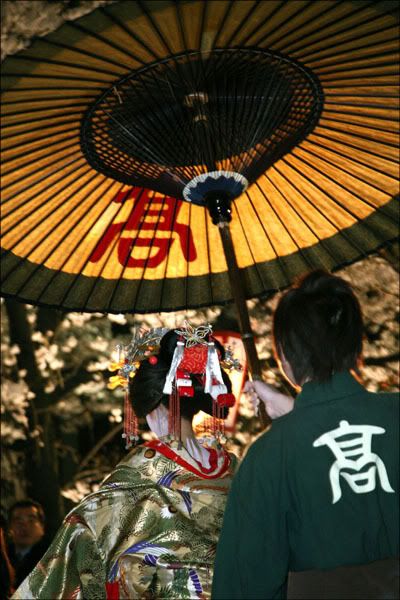
Spurned as the lowest class of citizen in the feudal Japanese heirarchy, merchants were seen as blood-thirsty parasites leeching off the hard work of others. Their wealth could not buy them respect or equaliy, except within the walls of the pleasure quarters, where, for the right price, they would be treated and entertained like kings.
"The courtesans of the pleasure quarters were trained in various arts: music, dance and poetry as well as other forms of entertainment that up until that time had been known only to the nobility. As times changed so did the tastes of the customers. The formality and expense involved meant that only the elite were able to patronize the Tayu (the top level courtesans). "
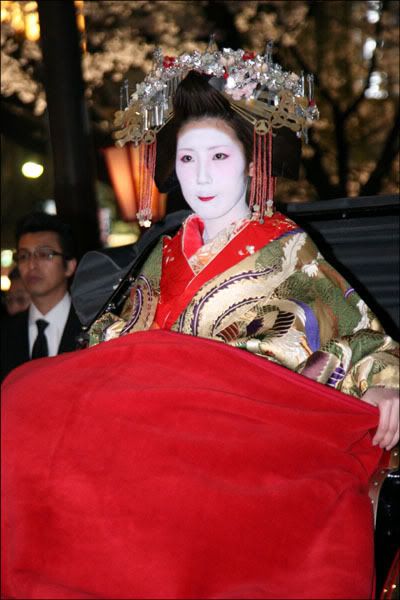
An apprentice Tayuu bundled beneath a bright red blanket as she arrives by riksha.
Liza Dalby describes the "Great Court Ladies", as Tayuu were known, in legendary proportions:
As times changed, so did the tastes of their patrons. The flashy appearance and antiquated customs of the Tayuu began to loose their allure, and when the first female geisha appeared on the scene in the 1700's, it marked the begining of the end. The last recorded Oiran (as Tayuu were known in Edo) served in 1761. Only in Kyoto do a few women continue to practice and preserve the cultural arts of the Tayuu.

The full regalia of a Tayuu weighs about 30 Kilos.In addition, they also wear tall, black lacquered koma-geta (wooden clogs) with three legs. Even in winter, Tayuu refrain from wearing the white, fitted tabi socks that geiko and maiko wear. This tiny hint of bare flesh peaking out from beneath the many layers of her luxorious silk kimono must have been very appealing to a Tayuu's Edo period patrons.


Kisaragi Tayuu ducks into a ryotei, a traditional dining establishment, along Kiyamachi-dori.
The perfect way to end an incredibly Kyoto-culture packed day of exploring Kiyomizu-dera and hanging out with maiko was with an extremely rare evening procession of Tayuu beneath the cherry blossoms.
As Peter MacIntosh explains on the Kyoto Sights & Nights website:
"Since medieval times Japan has always had some form of pleasure quarter offering various forms of entertainment, including, of course, the erotic. However, it was during the Edo period’s sakoku (1639-1854) when Japan cut off all ties with the outside world, that Japanese culture, as it is known today, flourished.
It was in these walled-in pleasure quarters such as Kyoto’s Shimabara, Tokyo’s Yoshiwara, and Osaka’s Shinmachi that the chonin (merchants) spent much of their time and money cultivating the arts."

Spurned as the lowest class of citizen in the feudal Japanese heirarchy, merchants were seen as blood-thirsty parasites leeching off the hard work of others. Their wealth could not buy them respect or equaliy, except within the walls of the pleasure quarters, where, for the right price, they would be treated and entertained like kings.
"The courtesans of the pleasure quarters were trained in various arts: music, dance and poetry as well as other forms of entertainment that up until that time had been known only to the nobility. As times changed so did the tastes of the customers. The formality and expense involved meant that only the elite were able to patronize the Tayu (the top level courtesans). "

An apprentice Tayuu bundled beneath a bright red blanket as she arrives by riksha.
Liza Dalby describes the "Great Court Ladies", as Tayuu were known, in legendary proportions:
"These women were dubbed "castle-destroyers" (keisei) because their sex appeal, like the mythical beauties of history, could destroy a man as easily as any army. These courtesans wore layers of ornately decorated kimono and a multitude of lacquer and tortoiseshell combs in their hair. Their wide, brocaded obi were tied in front — not, as some suppose, because it was easier to undress that way, but because that was the practice of married women and a yuujo was, in a sense, a wife for an evening. "
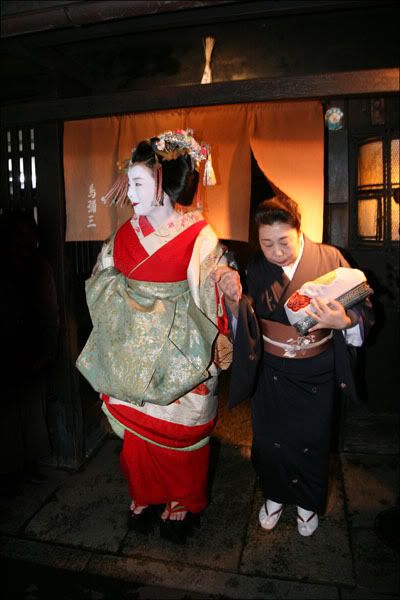
Kisaragi's obi is tied in front in the style of a full-fledged Tayuu.
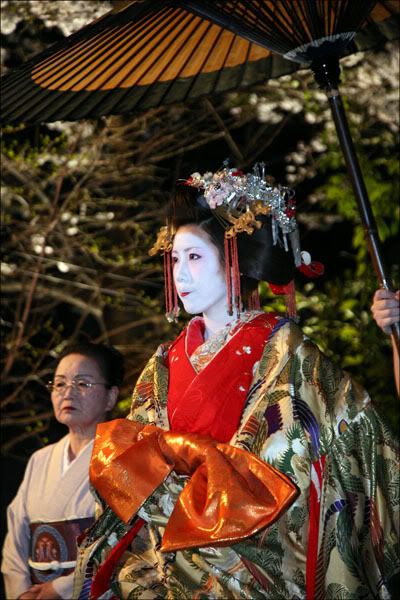
As an apprentice, her obi is tied in a bow.

Kisaragi's obi is tied in front in the style of a full-fledged Tayuu.

As an apprentice, her obi is tied in a bow.
As times changed, so did the tastes of their patrons. The flashy appearance and antiquated customs of the Tayuu began to loose their allure, and when the first female geisha appeared on the scene in the 1700's, it marked the begining of the end. The last recorded Oiran (as Tayuu were known in Edo) served in 1761. Only in Kyoto do a few women continue to practice and preserve the cultural arts of the Tayuu.

The full regalia of a Tayuu weighs about 30 Kilos.In addition, they also wear tall, black lacquered koma-geta (wooden clogs) with three legs. Even in winter, Tayuu refrain from wearing the white, fitted tabi socks that geiko and maiko wear. This tiny hint of bare flesh peaking out from beneath the many layers of her luxorious silk kimono must have been very appealing to a Tayuu's Edo period patrons.

The towering "three leg" geta of the Tayuu.
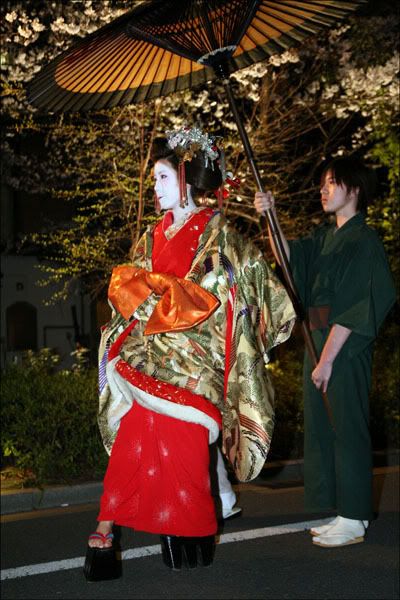
As if balancing beneath the burden of their elaborate costume on 12-15 inch platforms is not enough, Tayuu walk in what is often called a "figure eight" fashion, sliding one foot out slowly in an arch away from the other before drawing it back to center. Pausing with her bare foot exposed from beneath her crimson kimono, almost perpendicular to the other, she then points her foot forward and begins again. It takes a great amount of skill, balance, and practice to perfect, and they often hold the hands of their chaperone to help.

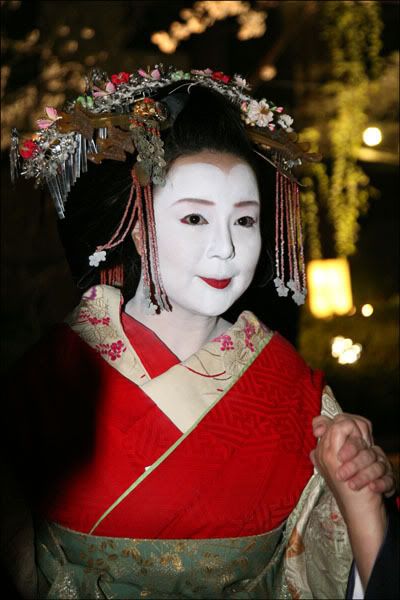

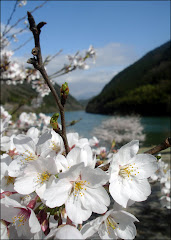

13 comments:
beautiful pictures, is it for a wedding?
Again beautiful pictures! And I can't wait for the text ^_^. Personally I think the tayuu of the fifth picture is the most beautiful one. Do you also now her name?
Kyuukaryuko: I believe her name is Kisaragi Tayuu.
Thank you Melissa, also for the text! Kirasagi is just so very beautiful.
Aww
Is so beautiful!
I've just discovered your blog! Is so interesting.
I'm mexican and I live in Japan!
Greetings!
hay maz...into tayuu now :-DDD
i named them here for u :-0
http://www.flickr.com/photos/wwps/sets/72157604677773236/
enjoy my friend
its so exciting, awesome writing and pictures
that is very nice photos.
its married photos.
Thank you very much.
Suat.
http://www.suatduman.com.tr
Awesome writing and images :) loved it xd !!
It sounds like it would take forever walking around like that.
ummm i hope you guys know what oiran/tayuu are... i wouldn't exactly say it's a good thing but i'm not one to judge.
if you don't and actually care then you should look it up.
lol I was just wondering the same thing, about an apprentice Tayuu...how odd. Then again, they might just be more Geiysa then the actual Orian these days.
"ummm i hope you guys know what oiran/tayuu are... i wouldn't exactly say it's a good thing but i'm not one to judge.
if you don't and actually care then you should look it up."
I see you point,prostituion is always terrible,violence against women(the girls was sold to the brothels,so no one can say they choose that)But the nowadays appreciation for tayuus and oirans are just for their arts,nothing else.
Maria
Post a Comment